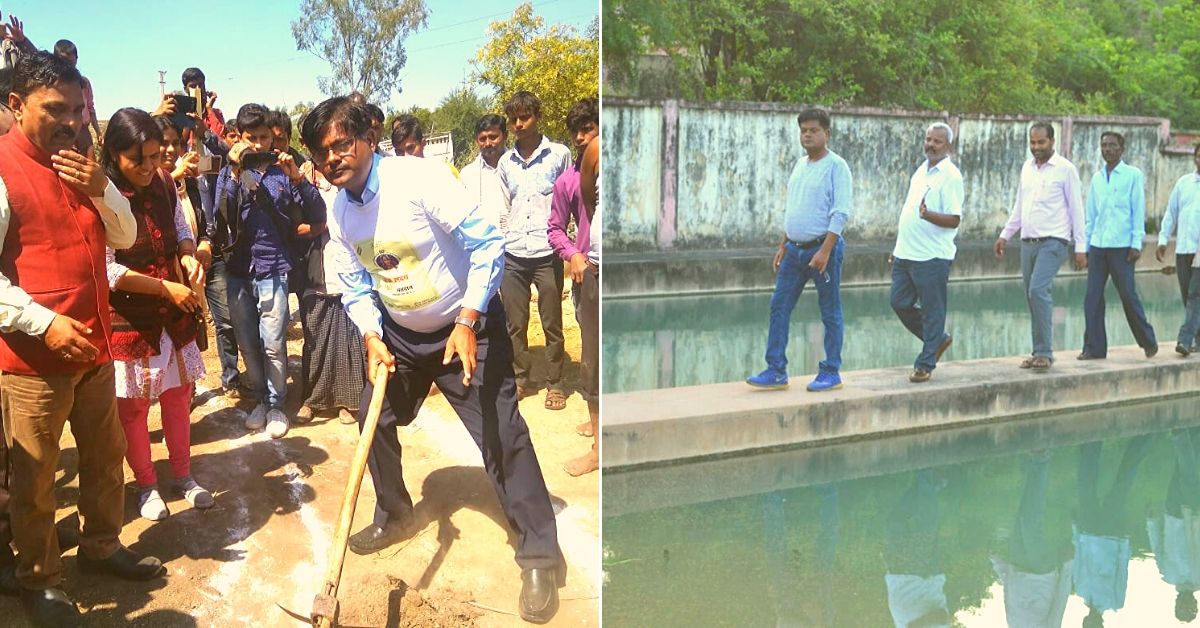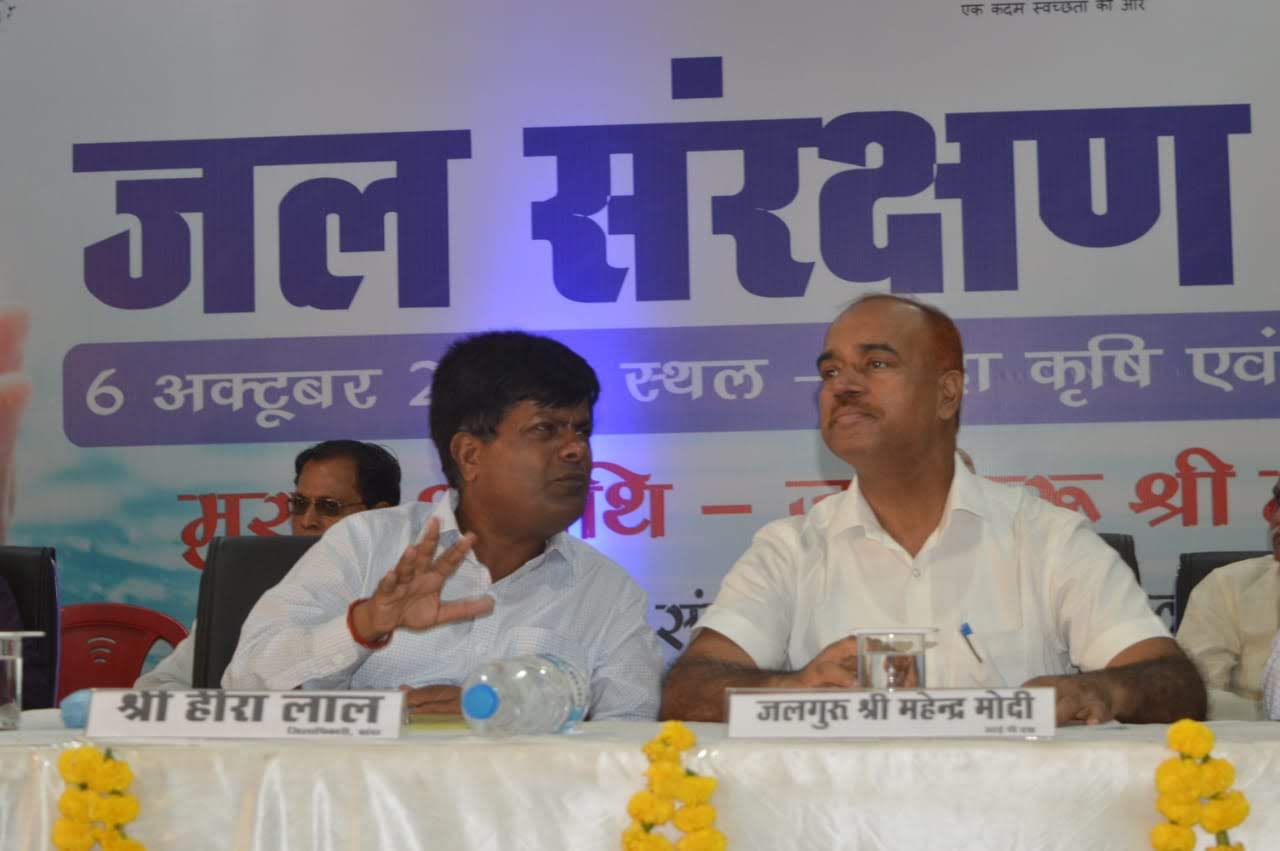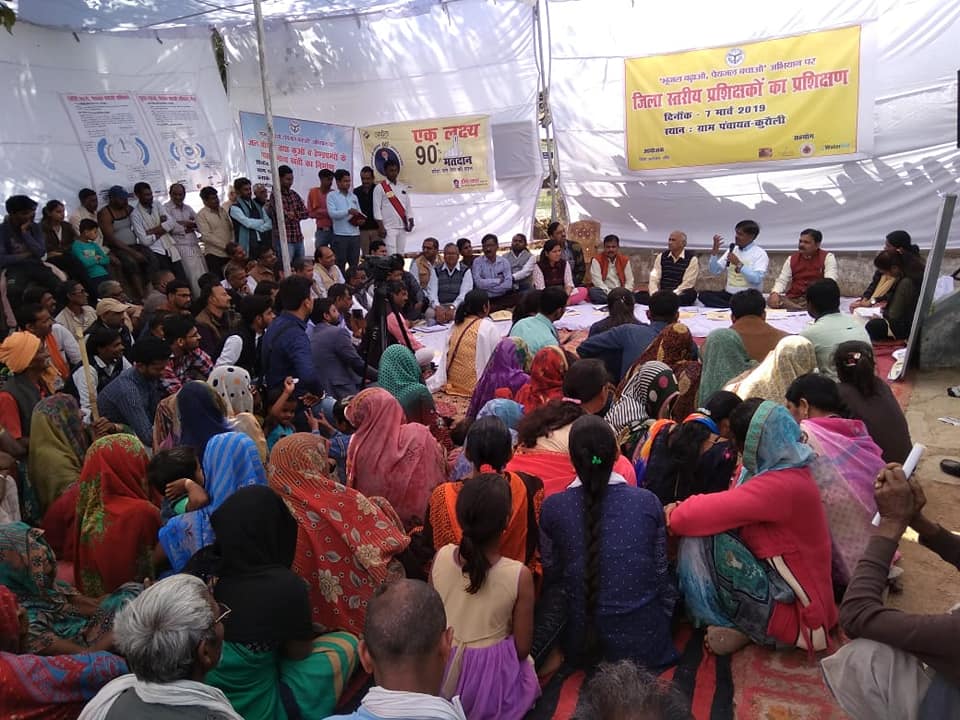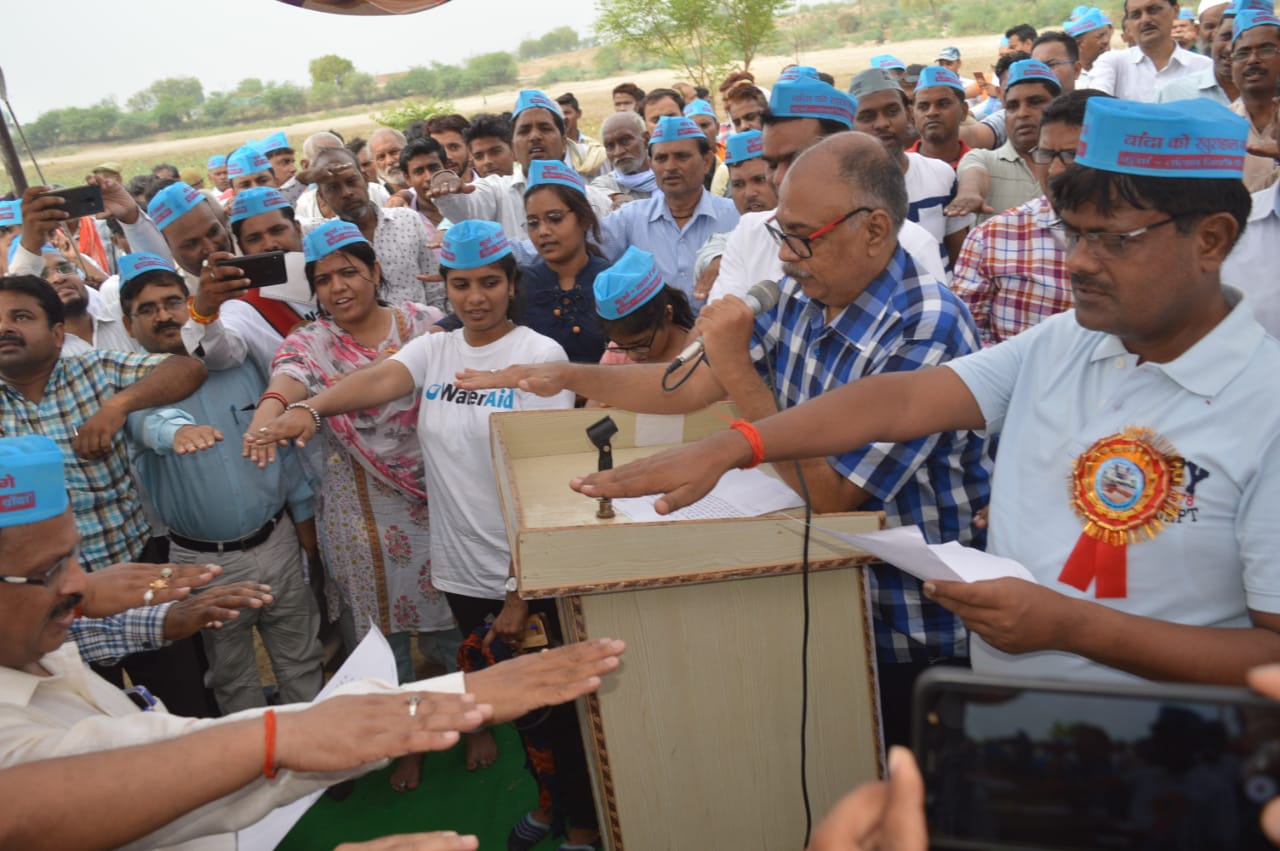UP IAS Officer Mobilises 470 Drought-hit Panchayats, Revives Wells & Ponds!
District Magistrate Heera Lal helped motivate the people, who raised a district brought to its knees by drought all the way to the cusp of water self-sufficiency.

Before his posting in Uttar Pradesh’s Banda district, Heera Lal, a 1994-batch Provincial Civil Service (PCS) officer later promoted to the IAS in 2010, had extensively studied the groundwater crisis in the drought-affected Bundelkhand region.
When he finally got his posting in September 2018, he took it upon himself to resolve the issue.
This water-saving device can easily be retrofitted onto most standard taps to save up to 80% of the water that would have otherwise been used up with a normal tap!
The crisis is genuine. According to WaterAid, a non-profit working with the district administration, more than 70% of the wells are showing rapid groundwater depletion with 50% wells showing 0-2 metre, 7% showing 2-4 metre and 15% indicating more than 4-metre depletion annually.
“This region has suffered a persistent water problem, so ponds and wells—the main sources of water—were prioritised. Of the total 7508 wells, only 3223 still have water in them; the rest have dried up, and the reasons for that are both man-made and natural. On the other hand, of the 2292 ponds in the district, only 1193 have water in it; the rest have either dried up or been acquired by people,” says a Firstpost report.
Although the district receives an annual rainfall of 800 mm, the inability to store it and the difficult topography marked by barren hilly terrain with sparse vegetation makes it hard for groundwater recharging.
Falling groundwater levels and dying water bodies are a consequence of neglect.
When people depended on the pond, they took care of it. When the wells came up, they forgot about the ponds. When hand pumps came, wells were neglected. When piped water supply arrived, all those hand pumps saw neglect.
This is a general sequence of events not just in Banda but all over India. Consequently, the district administration went on a massive public awareness campaign and instituted critical interventions for groundwater recharge across eight blocks covering 470 Gram Panchayats.
“With time, people had moved away from wells towards hand pumps and ignored ponds for tube wells. My main objective is to reconnect people with their traditional repositories of water, particularly the wells and ponds, which had fallen into neglect and disuse, and revive groundwater levels,” says Lal, in a conversation with The Better India.
The campaign began on October 6, 2018, and falls into two key phases with the May 2019 general elections dividing them.
The first phase of this water conservation effort called the ‘Bhujal Badhao, Peyjal Bachao’ (Increase Groundwater, Save Drinking Water) saw a mass awareness campaign on water budgeting for local officials and residents, besides the construction of contour trenches near-critical water sources like hand pumps and wells to conserve water. Following the recommendation of Mahendra Modi, an advisor to the Department of Urban Development, the district initially emphasised these elements.

But how do you get residents to participate in these initiatives and take ownership of them?
In the case of Banda, this means establishing a connect between the new district magistrate and the general public. The first step in this regard was organising a Startup and Innovation Summit between 28-30 January 2019.
Held at the district medical college, it saw a gathering upwards of 50,000 people. Aside from starting a conversation about water conservation, the event saw a burgeoning relationship between people and the administration.
“The next step in building this relationship with the public was the administration’s mission to increase voter turnout in the district before the general elections. The results were spectacular. Banda saw one of the highest increase in voter turnout percentage in UP,” says Lal.
With the momentum generated from the voter turnout campaign, they seamlessly went into the second phase of reviving traditional ponds and wells under the Kuan Talab Jivao Abhiyaan (Well and Lake Revival Campaign). However, before we get into the second phase, it’s imperative to understand the groundwork that went into the first phase following the startup summit.
“We developed certain tools to address this problem—introducing water budgeting techniques and designing of contour trenches nearby by water points. This involved training officers from the district to the Gram Panchayat on how to construct contour trenches near hand pumps and water wells based on a predefined module for rainwater harvesting, water budgeting techniques and other groundwater-related concerns. The administration then conducted a Jal Choupal, raising awareness about the issues mentioned above across all villages in one day, followed by the construction of contour trenches near hand pumps and wells using the same SOP discussed at the Jal Choupal,” says Dr Shishir Chandra of WaterAid.

These activities happened throughout February and March. With the focus on saving water, conserving water near hand pumps and wells, and enhancing groundwater table, they developed contour trenches that allow rainwater to percolate down.
“These were constructed near hand pumps to raise awareness about the importance of saving water in these parts and foster a sense of community participation. In one day, 2,655 contour trenches were constructed across the whole district,” informs Dr Shishir.
“The total recharge capacity created as a consequence of contour trenches built was 11,001 cum (KL) in the district with storage volume of all trenches at 3,930 cum (KL),” he adds.

“Raising awareness about water budgeting was also a critical part of the programme, giving locals a clear sense of how much water they use and the amount available. For personal use, we would ask them questions about the amount of water they used to relieve themselves in the bathroom, bathing purposes, cooking and washing clothes and utensils. Following questions about personal use, we asked them similar questions about their irrigation practices and livestock use. We would then proceed to ask questions about the amount of water available in their own hand pumps and wells and the pattern of rainfall across the last 10-15 years,” says Prashansha Gupta of the Akhil Bhartiya Samaj Seva Sansthan, which worked with WaterAid.

In getting answers to these questions, they had some notion of how much water was being used and wasted. For example, if people would use 20 litres to bathe, they would tell them how 10 litres was enough. It came to a point that locals would call each other out for wasting water.
This phase of the campaign brought people together on the water crisis.
After the first phase of the campaign, these achievements were celebrated a few days after World Water Day on March 26 inviting all stakeholders.
“But the message from DM Sir was that ‘we won’t stop here’ and instead push ahead with the restoration of traditional wells and ponds that were in disrepair,” says Dr Shishir.
Following the general elections in May, the Kuan Talab Jivao Abhiyaan went into overdrive.
It began with cleaning the wells and ponds that were strewn with garbage after going into disuse. To ensure greater public participation, Lal started visiting villages and cleaning the water bodies. Watching him do it had inspired others.
“Initially, the mindset was that the solution for their water problem would either come from the state government or district administration. I told them that if the problem is with you, so is the solution. We convinced them utilising the same modes of canvassing we saw in the contour trenches construction phase,” mentions Lal.

Instead of digging new wells, the administration encouraged them to deep clean existing ones. Working alongside the likes of WaterAid, they also began developing recharge wells in villages and connecting rooftop rainwater harvesting systems with them. This was to ensure that rainwater directly percolated down to raise the water table.
“The concept behind recharge wells is that water collected in the well would percolate into the ground, and recharge shallow aquifers. Shallow aquifers are water-bearing formations that exist about 10-100 ft underground, which usually get replenished during rains,” says Citizen Matters.
With ponds, it was more about desilting and deepening them so that it increases the water-holding and recharging capacity. Besides, there was a move to dig more of these ponds.

How did the administration proceed with it?
“Gram panchayats would identify ponds and wells that require work. Both elected officials and residents got involved in the deepening and desilting of the pond. At least, all panchayats have desilted their ponds. Cleaning of wells, which were once converted into dumping yards, are also activities they have taken up with great rigour by all gram panchayats,” says Dr Shishir.
“We motivated them to work utilising government schemes like MNREGA, through which they cleaned wells and ponds. Then, a fund at the village level, which is managed by the pradhan and secretary (14th Finance Commission report) was utilised. The agriculture department chipped in with its Khet Talab scheme, through which we are digging 2000 ponds and encouraging the participation of local labour. Thus far we have dug 835 under the Khet Talab Scheme. Lastly, we encouraged bigger farmers with large holdings to dig a pond in the middle of their land to store rainwater, use it and raise the water table,” says Lal.
“During the monsoons, however, we couldn’t dig ponds or clean the wells. Instead, we built rainwater harvesting systems in schools and different communities,” says Prashansha.
Phase 2 saw a lot of progress, claims Dr Shishir. Over 550 old community ponds were desilted and covered, 874 dug wells rejuvenated and 1,737 rainwater harvesting structures constructed in schools, panchayat offices, block offices, hospitals, official district buildings, etc.
Although the district administration, working alongside some non-profits, followed the same modus operandi as they did in Phase 1, there were some key differences. One key difference was that Phase 2 didn’t see an emphasis on water budgeting.
Moreover, to clean, desilt, and reinvent ponds/wells takes time. Also, how do you monitor these activities?
Well. they developed an ICT based monitoring tool called M-Water Application, an open web portal to monitor construction and progress.
“The DM also played a critical role in mobilising people from the local community for this effort, which we needed more of for the revival of ponds and wells. To boost their motivation and engage the people regularly, he would also regularly conduct awareness campaigns, marches and functions,” says Dr Shishir.

One such campaign was the Kuan Talab Puja.
“The people of Bundelkhand are deeply religious. Referencing their faith, we would highlight the critical need for water conservation. Earlier, they would earlier throw garbage into wells. However, in invoking a religious angle to water conservation, there came a time when people wouldn’t even wear slippers to the well out of respect,” says Prashansha.
Speaking to Firstpost, Jamuna Prasad, 47, a farmer from the Pandui village, says, “Our forefathers told us that if we have to bring back lost water, then trenching should be done from time to time. Our generation did not care for water and ecological conservation until they lost it. Now the villagers have started doing this again and the District Magistrate, with help from a few non-governmental organizations (NGOs) like Water Aid and others, is encouraging the villagers to do it on a large scale. This is very effective and we all know that it will help us in years to come because water recharging in pre-dug ponds and wells is easy while it takes a lot of time in the new water bodies.”
Despite all the success, challenges remain, a major one being the problem of illegal structures that have been built on top of dry ponds. “Having said that, people have received this initiative very well. There is a belief in the ability of the administration to address their concerns. More importantly, however, people have taken ownership of these initiatives because they understand the urgent need for a permanent solution,” concludes Lal.
Also Read: The Tiffin Box is Transforming a Remote Assam District, Thanks to this IAS Officer
(Edited by Gayatri Mishra)
Like this story? Or have something to share? Write to us: [email protected], or connect with us on Facebook and Twitter.

Similar Story

Ex-IRS Officer’s Free UPSC CSE Course Eliminates Need for Paid Coaching
An IRS officer-turned-educator, Ravi Kapoor has mentored thousands of UPSC aspirants for free. Taking upon his 10 years of bureaucratic experience and masters in clinical psychology, Ravi’s approach to UPSC mentorship has always kept mental fitness and motivation in focus.
Read more >
If you found our stories insightful, informative, or even just enjoyable, we invite you to consider making a voluntary payment to support the work we do at The Better India. Your contribution helps us continue producing quality content that educates, inspires, and drives positive change.
Choose one of the payment options below for your contribution-
By paying for the stories you value, you directly contribute to sustaining our efforts focused on making a difference in the world. Together, let's ensure that impactful stories continue to be told and shared, enriching lives and communities alike.
Thank you for your support. Here are some frequently asked questions you might find helpful to know why you are contributing?


This story made me
-
97
-
121
-
89
-
167












